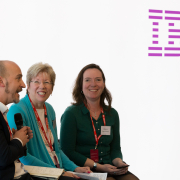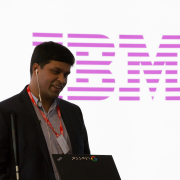How AI could transform the lives of disabled people
Claudia.Cahalane | 11 Dec 2017 “The Echo Dot makes me feel included," says Ellie Southwood, chair of The Royal National Institute of the Blind (RNIB). “I spend far less time searching for things online; I can multi-task while online and be more productive. Microsoft’s Seeing AI app (narrates the world for people with sight loss) means I can recognise people and scenarios and make up my own mind about what’s going on.”
“The Echo Dot makes me feel included," says Ellie Southwood, chair of The Royal National Institute of the Blind (RNIB). “I spend far less time searching for things online; I can multi-task while online and be more productive. Microsoft’s Seeing AI app (narrates the world for people with sight loss) means I can recognise people and scenarios and make up my own mind about what’s going on.”
Southwood (pictured right with Hector Minto of Microsoft and Sharon Spencer of IAAP), who has sight loss, made the comments at AbilityNet/ RNIB’s TechShare Pro conference in November, which focused on AI, disability and inclusive design. News about Artificial Intelligence (AI) can often present a dystopian version of the future - cars let loose on the motorway driving themselves; robots controlling our thoughts and taking jobs. But this sold out London conference looked at the many ways that advances in AI could transform the lives of disabled people.
The power of AI
AI is fast becoming part of our lives. The technology is behind the likes of Siri, Alexa, Cortana and other similar services. It powers speech-to-text service and is getting better at understanding different voices. It’s responsible for the suggested responses on GMail, auto-captions on Facebook and picture library searches for a specific location or person.
Opening the event, IBM’s evangelist for its AI database Watson, Jeremy Waite, told delegates that the company's survey of 1,200 UK executives found 28% plan to invest in AI in the next year. Watson can search 10 million records a second - for example it can find specific words in the whole back catalogue of TED talks in seconds or less.
AI and accessibility
The biggest tech companies’ use of AI within their products is seeing new tech features becoming far simpler for everyone to use, including disabled people. And by investing in inclusive designs those products are now reaching bigger audiences - accessible designs are more popular with every customer.
“Hopefully AI means that, rather than expecting people to provide something in an accessible format, it will mean that everything becomes accessible in the future,” said Hector Minto, head of accessibility and assistive tech at Microsoft, who sat on a future-gazing panel at the event. He spoke about the new Microsoft Seeing AI app, w hich enables blind people to recognise faces, scenes, money, text and more, and also about a range of other Microsoft features which use AI to reduce or remove the technology barriers that disabled people face.
hich enables blind people to recognise faces, scenes, money, text and more, and also about a range of other Microsoft features which use AI to reduce or remove the technology barriers that disabled people face.
For example Windows Hello uses biometric login, ie fingerprint, face or iris, which can work for people with physical disabilities or those with dyslexia who might struggle to remember passwords. Subtitles in Powerpoint mean people can save a transcript of the narration which happened alongside slides and keep the transcript.
Minto added that the big opportunity for AI - with advances in translation capabilities and free apps - is that it could help assistive technology could 'go global' and reach parts of the world where there are more disabled people and fewer services and support.
Biometric logins and disability
Delegates also heard from Kiran Kaja, technical programme manager for search accessibility at Google.
“Everyone wins when we harness AI,” he said. “Voice recognition was developed for disabled people, but it’s the hot item at the moment and is useful for everyone. The same with speech-to-text technology, which is completely based on renewal networks. This uses AI and predictive text is also AI. Google wants to use intelligent tech to improve customers experience,” said Kaja, who has sight loss.
Kaja spoke about Google Home’s connection to Smart devices and the potential of home automation technology to support disabled people. In particular, people with physical disabilities or sight loss can more easily do things like turn lights on and off, alter a thermostat and turn on home appliances using such technology.
- See live recordings of speakers at TechShare Pro and find out the latest on AI, new technology and disability at www.abilitynet.org.uk/techsharepro .



